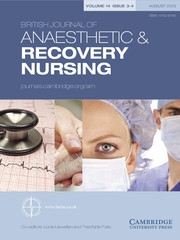No CrossRef data available.
Article contents
Regional Anaesthesia versus General Anaesthesia in Endovascular Aneurysm Repair: The Surgical Nursing Interventions
Published online by Cambridge University Press: 01 February 2009
Abstract
Minimally invasive surgical techniques are a revolutionary and innovative approach to the practice of surgery. Endovascular aneurysm repair (EVAR) may offer a number of significant advantages in comparison with conventional open surgical repair.
The purpose of this study was to compare regional anaesthesia (RA) and general anaesthesia (GA) in EVAR, and to describe the surgical nursing interventions.
This included a retrospective analysis of 160 consecutive patients (age 55 to 96 years) who underwent EVAR under: epidural anaesthesia (EDA = 60 patients), combined spinal and epidural anaesthesia (Combined = 40 patients) and GA = 60 patients.
Results were successful in all patients and no mortality was noticed. Among the GA group, 11 patients needed ICU support while only 5 from the other 2 groups. Furthermore, a statistically significant difference regarding median hospital stay was also noticed in favour of the regional group.
In conclusion, RA is a safe and effective anaesthetic method for endovascular repair of abdominal aneurysms, offering several advantages including simplicity, haemodynamic stability, less need for ICU management and reduced hospital stay. The anaesthetic nurse can play a major role in the management of this anaesthesia throughout the procedure.
Keywords
- Type
- Original Article
- Information
- British Journal of Anaesthetic & Recovery Nursing , Volume 10 , Issue 1 , February 2009 , pp. 11 - 14
- Copyright
- Copyright © British Association of Anaesthetic and Recovery Nursing 2009


